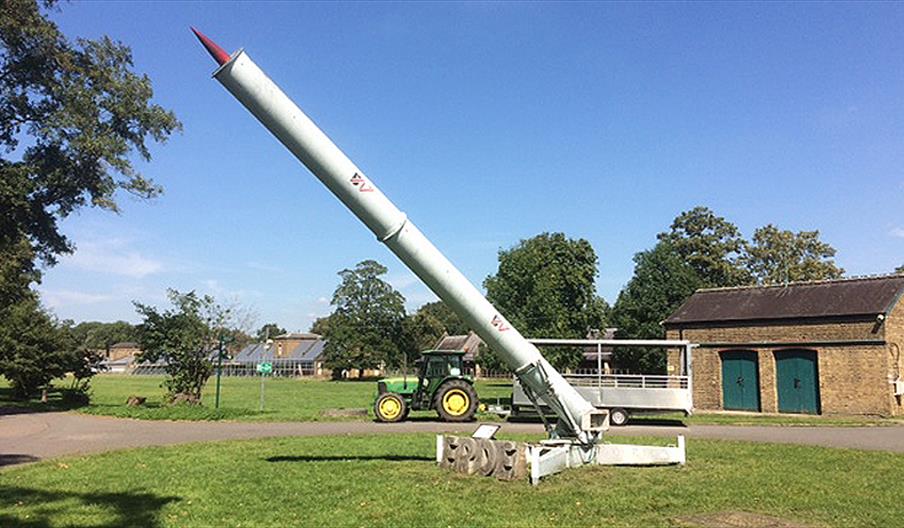Book Tickets Online
About
Today a visit to the Royal Gunpowder Mills is many things rolled into one. Visitors will find, a historic site which was at the forefront of science for over 300 years, a site containing many unique grade 1 and 2 listed buildings, a vast and unique wildlife habitat that is of special scientific interest (an SSI), home to unique canal and railway systems and, of course, the place that blasting powders (for mines and engineering) and military propellants (the things that burn to propel bullets shells and rockets) were manufactured.
As well as explaining in full detail the history and methods of manufacture, and the daily lives of the people involved, exhibitions on site include an insight into the end use of the products, the two most popular being the Armoury and the Rocket Vault. The Armoury shows the development of small arms (those carried by soldiers as their personal weapons) which used gunpowder (a mix of naturally occurring chemicals) and then smokeless propellants such as Cordite (man-made by chemical processes). The Rocket Vault covers the era after the Second World War when the use of the site changed to become a centre for the development of explosives and propellants for rocket motors and it became the Explosives Research and Development Establishment, renamed once more in the eighties as the Royal Armament Research and Development Establishment, retaining this name until it closed in 1991.
The Rocket Vault
The exhibition shows the development of rocket motors and propellants from Congreve's gunpowder rocket of the early 19th century through to the guided missiles of the cold war and those used in the Falklands and Gulf wars. Former employees are often on hand to give guided tours and answer any technical questions concerning rockets and propellants.
Among the exhibits on show are a rocket engine from a V2 that broke up in mid-air over Waltham Abbey in 1945, a Wolfhound motor from a Thunderbird anti-aircraft rocket of the cold war era, a Blowpipe ground to air missile from the Falklands war and a set of Skylark research rocket motors that provided valuable scientific information over a period of some fifty years. Also on show is an Exocet motor used by both sides in the Falklands war and a small liquid fuel engine from a Chevaline nuclear missile. Present day missiles include a Starstreak used on top of east London tower blocks during the 2012 Olympic Games and a Rapier motor used on the outer ring of missiles at the same event.
Also on show are examples of the various constituents of propellants used in rocket motors.
Outside is a 36 inch diameter Stonechat, the largest motor that we produced and a flight test vehicle for a Gosling booster for the Thunderbird and Bloodhound missiles.
The Armoury
One of the Royal Gunpowder Mills most popular attractions, it has a comprehensive collection of small arms and militaria which were recently acquired, catalogued and redesigned by The Royal Gunpowder Mills with the help of the Heritage Lottery Fund. The exhibition displays over 200 historic firearms covering the periods from the English Civil War to present day conflicts.
Volunteer staff are happy to explain the science, technology and history of the various types of weapons on display which include heavy medium and light machine guns, sub machine guns, manual and self-loading rifles, revolvers and pistols, mortars, rocket launchers and grenades.
Visitors are encouraged to handle and explore a variety of historic weapons - this "hands on" experience is very interesting and informative. The weapons come from all over the world and represent the small arms used by the major combatants from the English Civil War to present day conflicts.
The exhibition includes most of the weapons produced by the nearby Royal Small Arms Factory in Enfield, these include Bren guns including a rare 1938 dated MK1, .455 and .38 revolvers, Sten guns and self loading rifles. Helmets, hats, uniforms, badges, leather and webbing equipment, flags, swords, bayonets and spears complete the display and the comments in our visitor book confirm that it is well worth seeing.
Map & Directions
Road Directions
We are located between Waltham Abbey & Waltham Cross, off Highbridge St. (across from McDonalds).
Entrance at top north end of Beaulieu Drive.
The site is a 10 minute walk west from Waltham Abbey Town Centre.
By Road:
From J26 of M25, take A121 to Waltham Abbey; or from J25 of M25 go to Waltham Cross and then A121.
Public Transport Directions
By Underground:
From Loughton station (central line) - Bus 66 towards Debden.
By Bus:
The site is around a 10 minute walk from Waltham Abbey Town Centre. Nearest bus stops in Highbridge Street are served by the following local buses: 251 , 66 , 86 and 13
Travel information: Traveline - 08712 002233
By Rail:
Nearest station is Waltham Cross, connecting London Liverpool Street, Stratford or Tottenham Hale underground (Victoria Line) to/from Cheshunt/Broxbourne/ Hertford East
Connection can also be made at Theobalds Grove (London Overground) via Hackney Downs or Seven Sisters and then to Highbridge Street via 251 bus.
We are a 25 minute walk east from Waltham Cross station.
You may also take a bus or a cab (office at station).
Travel information: National Rail- 08457 484950 Transport for London- 020 7222 1234
By Foot
The Royal Gunpowder Mills is situated within Lea Valley at Section 1 of 6 - Details of how to get here from Lee Valley can be found by clicking here
For further details of Section 1 of the Lee Valley Walk - spanning from Waltham Abbey to Ponders End click here















